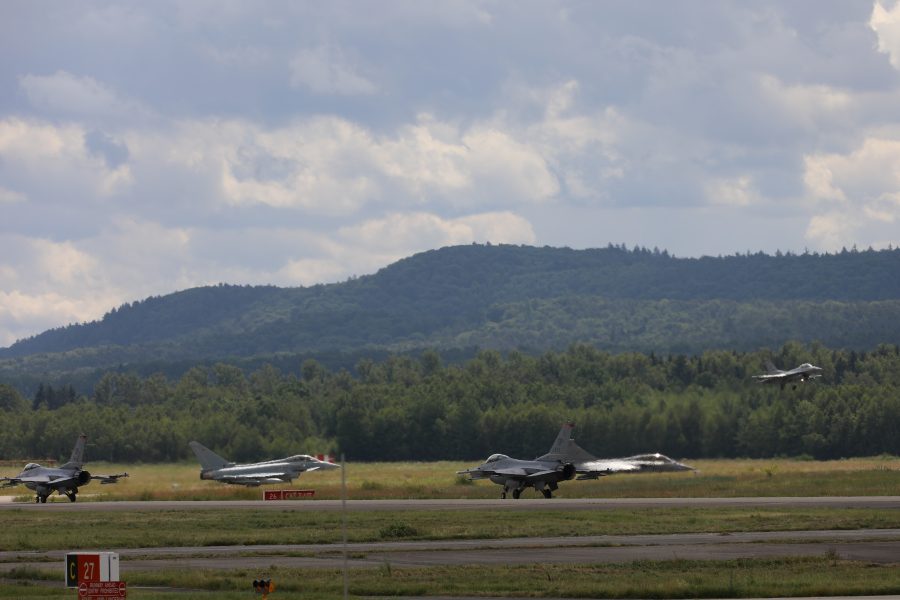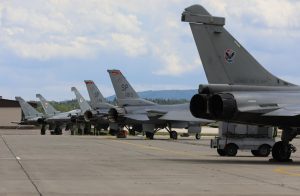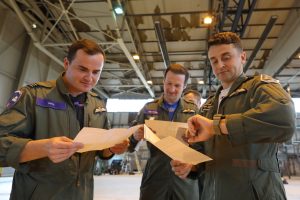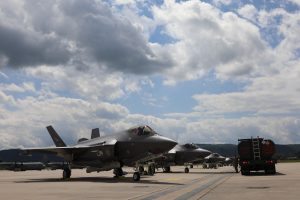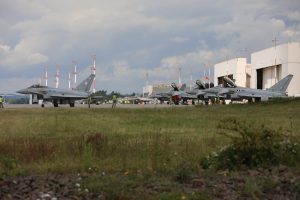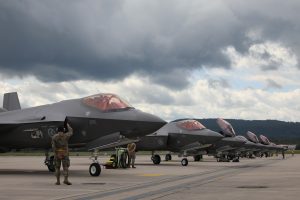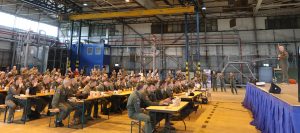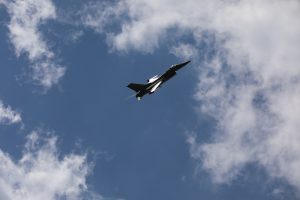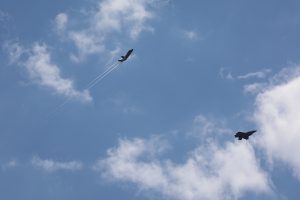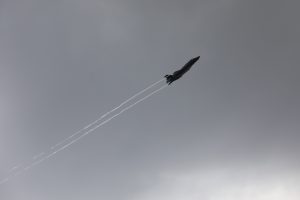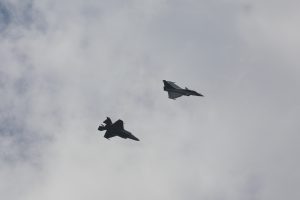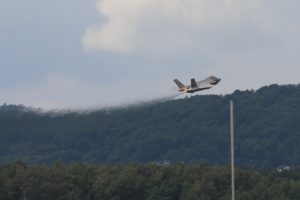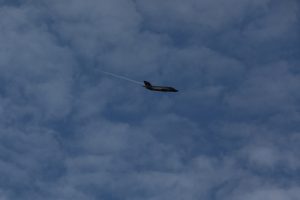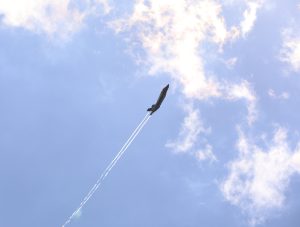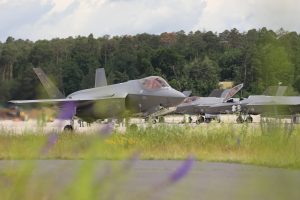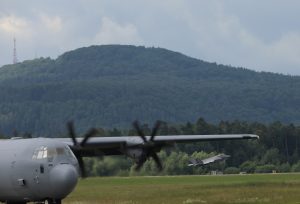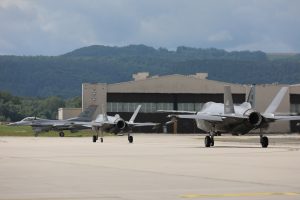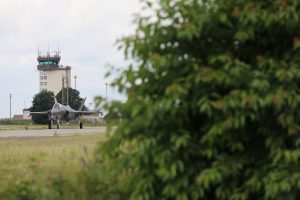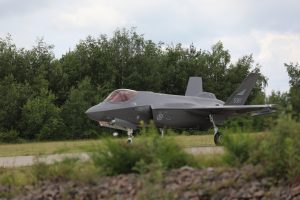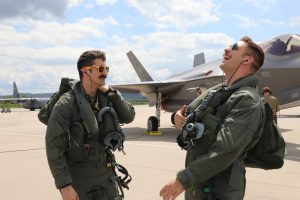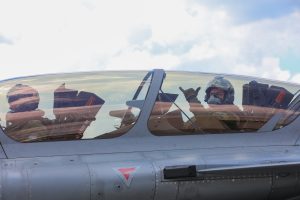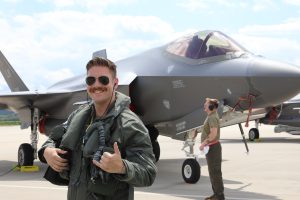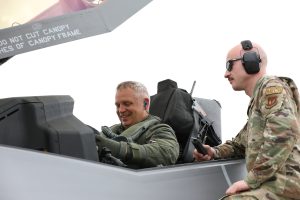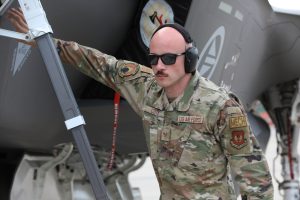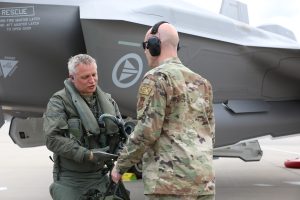RAMSTEIN AIR BASE, Germany—In the span of roughly eight hours, 37 NATO fighters took off in rapid succession. The one-on-one fighter competition conducted on June 6 was a first for U.S. Air Forces in Europe-Air Forces Africa (USAFE-AFA) and the air base here.
The pilots did not know who they would be facing until they encountered their opponent in close proximity at more than 10,000 feet. They did not know exactly when they would be flying until they received an envelope at the end of the morning briefing. By the end of the day, pilots flew 67 sorties against each other.
“Dissimilar air combat is fundamental for all our air forces,” Deputy NATO Allied Air Commander Royal Air Force Air Marshal Johnny Stringer told Air & Space Forces Magazine. “It’s a fantastic test of at one level of just foundational air combat skills that all of our fighter pilots still need to possess.”
Air & Space Forces Magazine was granted unusual access to the exercise, close enough for the reporter to be blasted with jet wash multiple times on the flight line.
As aircraft, sensors, and weapons have gotten more advanced, the U.S. and the rest of NATO anticipate that many real-world engagements will be conducted beyond visual range. But the Ramstein exercise provided pilots with a chance to hone their basic fighter maneuver skills as they merged in the sky.
Adding to the challenge, the maneuvers involved dissimilar fourth- and fifth-generation types of fighters, including a multinational collection of F-16s, Eurofighter Typhoons, F-35s, and French Rafales. Nine of NATO’s 32 members participated: the U.S., the Netherlands, Belgium, France, Germany, the U.K., Denmark, Finland, and Norway.
The wide array of aircraft was a far cry from much of the U.S. Air Force’s training—USAF aggressor squadrons usually fly only F-16s and F-35s.
“Forcing rapid decision-making, applying tenants of dissimilar air combat, where you’re immediately processing what you’re fighting so that you bring your best advantages to bear and hopefully minimize disadvantages in your platform,” Stringer said of the objective for pilots.
The exercise featured F-35s from the U.S., the U.K., the Netherlands, and Norway—unsurprising given that 600 of them will be operating in Europe by the end of the decade. But it was the dissimilar training, which harkens back to the Cold War, which made it especially distinctive.
“This is something that is a learning experience that I haven’t seen in many, many years,” said Col. Michael “T-Man” Trautermann, the senior German national representative to NATO Allied Air Command, recalling his experience in the F-4 Phantom where he would drop in at other nation’s bases. “We do not do that often enough, and these are things that need to be regained for NATO as an alliance to be able to be successful.”
The exercise was also a unique event for Ramstein and its Airmen. The base serves as a hub for U.S. military airlift capability around the world, and the nearby Landstuhl Military Medical Center is the key American military hospital outside the United States. The number of Americans on and around the bases is so large that a two-star general, Maj. Gen. Paul D. Moga—also the commander of the Third Air Force—is assigned to help manage the roughly 50,000 service members, families, and contractors. The Kaiserslautern Military Community, or KMC, is the biggest cluster of troops outside the United States.
But just about the only thing KMC generally lacks is fighters. Hundreds of locals gathered along the fence line in a country without a plane-spotting tradition to get a glimpse of fighters roaring through the air.
On base, Ramstein personnel helped marshall aircraft, pumped 160,000 gallons of jet fuel, and kept everyone safe in the skies through air traffic control. Though the base is large, the competition practiced the Air Force’s push toward building Airmen who can conduct a variety of tasks to complete a mission.
“I knew we were going to get value out of the fighting. But I didn’t understand what we were going to get here at Ramstein,” said Maj. Gen. Christopher F. Yancy, mobilization assistant to the commander of U.S. Air Forces Europe-Air Forces Africa.
“Rapid launch and recovery, ground ops … they did all those skill sets that we’re trying to exercise,” he added. “They’re used to working on heavies. They hadn’t worked on fighters.”
The airspace for the simulated fight was a 50-by-70-mile arena, divided in four roughly equal quadrants with a dogfight going on in each, according to an exercise planners. Each jet had 30 minutes to turn and burn to try to hit its foe with a simulated kill with guns.
Small maintenance footprints, some involving cross-national operations, were used to support the exercise. For the first time, Norway’s F-35s were serviced by U.S. maintainers.
“If you’re fighting with someone, it helps to know them,” said Norwegian Air Force Col. Martin “TinTin” Tesli, wing commander of Ørland Air Base, where the country’s F-35s are based, and a participant in the exercise.
Yancy also said the exercise proved valuable should the U.S. have to operate in a degraded communications environment, such as a wartime situation when modern fighters may have onboard systems jammed or command and control aircraft may be unavailable. Since the full-scale Russian invasion of Ukraine in 2022, both sides have used electronic warfare and air defenses that quickly upended pre-war plans.
“We may not be able to talk to somebody,” Yancy said. “To go out and not know who you’re going fight, you have to go, ‘Alright, my game plan is different for Hornet versus Rafale versus Tornado versus Typhoon versus Viper versus F-35, so I better have a little private time, or go to the vault with my weapons folks and figure out what my game plan is going to be for eight different aircraft. And I better be able to execute that.’”
Relationship building was also a key objective of the event.
“We can’t look at it as a bunch of lieutenants, captains, and majors. That’s the next air chief, that’s the next squadron commander,” Yancy said.
While fighter pilots are hyper competitive, steps were taken to prevent it from getting out of hand in order to ensure aerial safety. No trophies were handed out and no simulated wars were fought.
“What is the Alliance? Clue in the title,” Stringer said. “Because just getting people together to chat, as well as do the flying, talk about their platform. Our engineers, meeting, talking, looking around jets, doing elements of cross-servicing. What you will get out of 48 hours here is fantastic.”
